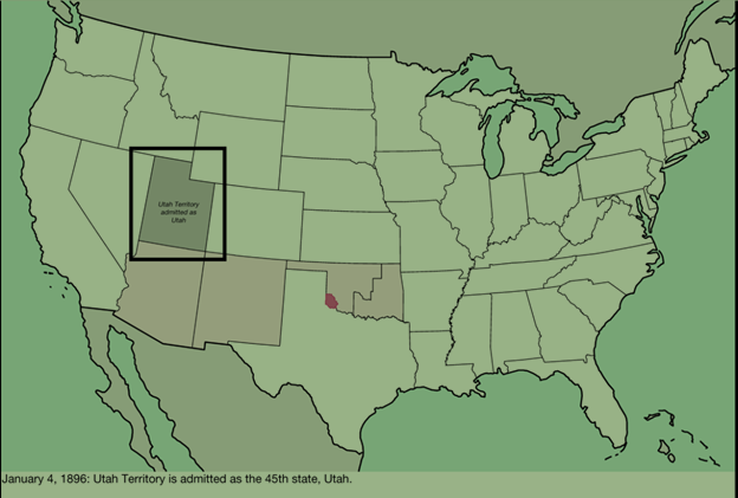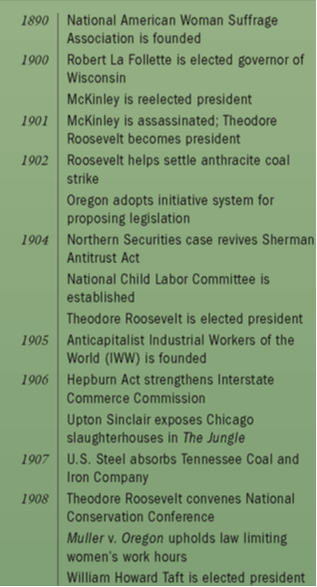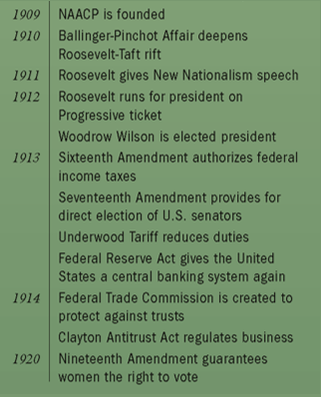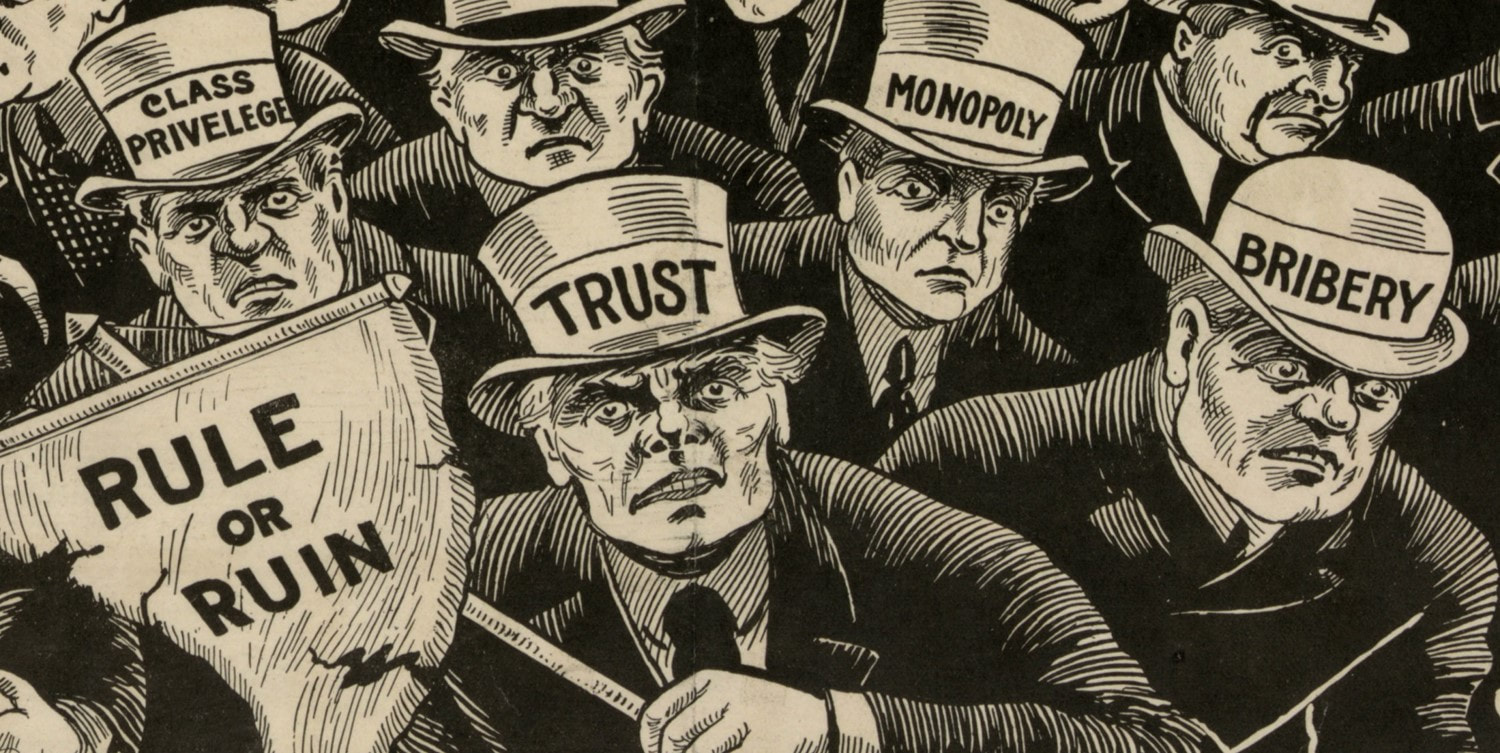|
Week 3: The Progressive Era
Welcome to HST 202 Week Three! This is the third learning module looking at the United States in the Progressive Era. Academics as done a real number on me. After countless hours sitting in a classroom, whether in the back row or up front giving a lecture, one thing stands out to me a pox on the American education system: The group project. Such a vile form of torture. Everyone remembers the first group project they had to do. Their middle school teacher pair you off with 2 to 4 other people to give a presentation on some topic or another. It was something you didn’t necessarily have a passion for, but you wanted to get a decent grade, so you were willing to work with others on this task. Now enters the actors. First, the bossy student that is the loudest and most insistent on doing thing THEIR way. They refuse to work with other and have a shared vision of only their vision. You know the type, self-aggrandizing that have an inflated self-worth. These are the people that run for political office someday. The other student is far more insipid. This person sits back quietly, doesn’t contribute, aside from nodding their head in approval occasionally. They promise to give the presentation after YOU make the poster board and YOU do all the research. As the group toils away laboriously, they sit and wait to deliver the speech portion, that everyone for some reason tries to avoid like the plague. Then, in an act of cunning treachery, the day the presentation is due, that kid is OUT SICK. So, the bossy kid makes you do the presentation, because when the rubber hits the road, the domineering kid is loud, not actually informed. You were played like a fiddle. Why this clearly anecdotal story? Rule number three of history: Credit is important. Everyone one, whether political party or ethnic group wants to take credit for the past. Who built what. Who was the first. In the scheme of things, this can seem innocuous, or harmless. But not if you ask “why” the credit is being taken.
HIGHLIGHTS
READING
Carnes, Chapter 21: The Age of Reform My classes utilize both Howard Zinn's Patriot's History of the United States and Larry Schweikart's Patriot's History of the United States, mostly in excerpts posted to the modules. You can access the full text of People's History or Patriot's History by clicking on the links. 
Zinn, Chapter 13 “The Socialist Challenge”
…On the afternoon of March 25, 1911, a fire at the Triangle Shirtwaist Company that began in a rag bin swept through the eighth, ninth, and tenth floors, too high for fire ladders to reach. The fire chief of New York had said that his ladders could reach only to the seventh floor. But half of New York's 500,000 workers spent all day, perhaps twelve hours, above the seventh floor. The laws said factory doors had to open outward. But at the Triangle Company the doors opened in. The law said the doors could not be locked during working hours, but at the Triangle Company doors were usually locked so the company could keep track of the employees. And so, trapped, the young women were burned to death at their work-tables, or jammed against the locked exit door, or leaped to their deaths down the elevator shafts. The New York World reported: .. . screaming men and women and boys and girls crowded out on the many window ledges and threw themselves into the streets far below. They jumped with their clothing ablaze. The hair of some of the girls streamed up aflame as they leaped. Thud after thud sounded on the pavements. It is a ghastly fact that on both the Grcene Street and Washington Place sides of the building there grew mounds of the dead and dying. .. . From opposite windows spectators saw again and again pitiable companionships formed in the instant of death-girls who placed their arms around each other as they leaped. When it was over, 146 Triangle workers, mostly women, were burned or crushed to death. There was a memorial parade down Broadway, and 100,000 marched. There were more fires. And accidents. And sickness. In the year 1904, 27,000 workers were killed on the job, in manufacturing, transport, and agriculture. In one year, 50,000 accidents took place in New York factories alone. Hat and cap makers were getting respiratory diseases, quarrymen were inhaling deadly chemicals, lithographic printers were getting arsenic poisoning. A New York State Factory Investigation Commission reported in 1912: Sadie is an intelligent, neat, clean girl, who has worked from the time she got her working papers in embroidery factories.... In her work she was accustomed to use a white powder (chalk or talcum was usual) which was brushed over the perforated designs and thus transferred to the cloth. The design was easily brushed off when made of chalk or of talcum. ... Her last employer therefore commenced using white lead powder, mixed with rosin, which cheapened the work as the powder could not be rubbed off and necessitate restamping. None of the girls knew of the change in powder, nor of the danger in its use.. . . Sadie had been a very strong, healthy girl, good appetite and color; she began to be unable to eat. . .. Her hands and feet swelled, she lost the use of one hand, her teeth and gums were blue. When she finally had to stop work, after being treated for months for stomach trouble, her physician advised her to go to a hospital. There the examination revealed the fact that she had lead poisoning.. .. According to a report of the Commission on Industrial Relations, in 1914, 35,000 workers were killed in industrial accidents and 700,000 injured. That year the income of forty-four families making $1 million or more equaled the total income of 100,000 families earning $500 a year. The record shows an exchange between Commissioner Harris Weinstock of the Commission on Industrial Relations and President John Osgood, head of a Colorado coal company controlled by the Rockefellers: WEIINSTOCK: If a worker loses his life, are his dependents compensated in any way? OSGOOD: Not necessarily. In some cases they are and in some cases not. WEINSTOCK: If he is crippled for life is there any compensation? OSGOOD: No sir, there is none.... WEINSTOCK: Then the whole burden is thrown directly upon their shoulders. OSGOOD: Yes, sir. WEINSTOCK: The industry hears none of it? OSCOOD: No, the industry bears none of it. Unionization was growing. Shortly after the turn of the century there were 2 million members of labor unions (one in fourteen workers), 80 percent of them in the American Federation of Labor. The AFL was an exclusive union-almost all male, almost all white, almost all skilled workers. Although the number of women workers kept growing-it doubled from 4 million in 1890 to 8 million in 1910, and women were one-fifth of the labor force-only one in a hundred belonged to a union.
ASSIGNMENTS
Remember all assignments, tests and quizzes must be submitted official via BLACKBOARD Forum Discussion #4
The Jungle is a 1906 novel by the American journalist and novelist Upton Sinclair. Sinclair wrote the novel to portray the harsh conditions and exploited lives of immigrants in the United States in Chicago and similar industrialized cities. His primary purpose in describing the meat industry and its working conditions was to advance socialism in the United States. However, most readers were more concerned with several passages exposing health violations and unsanitary practices in the American meat packing industry during the early 20th century, which greatly contributed to a public outcry, which led to reforms including the Meat Inspection Act. Sinclair famously said of the public reaction, "I aimed at the public's heart, and by accident I hit it in the stomach."
Watch this short clip (or read the Jungle in its entirety; whatever floats your boat!) and answer the following: Clearly, standards and federal regulations were needed during the late 19th century and early 20th century, but are they as important today in the 21st century? Are there free market solutions that keep businesses in check? Need help? Remember the Discussion Board Rubric.
0 Comments
Leave a Reply. |
AuthorRyan Lancaster wears many hats. Dive into his website to learn about history, sports, and more! Archives
April 2024
Categories |






 RSS Feed
RSS Feed